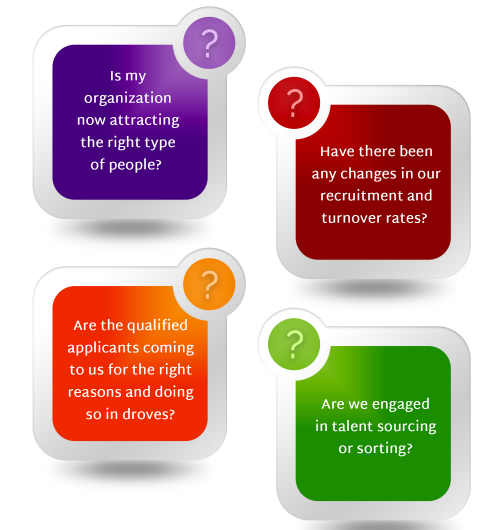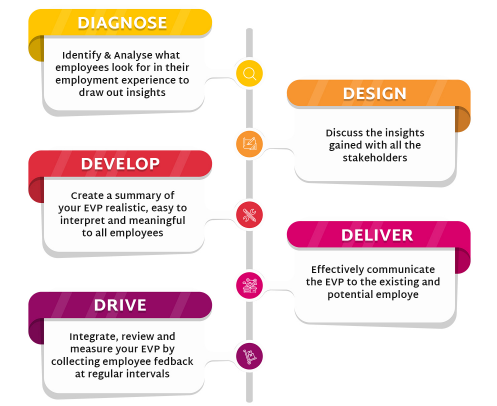Designing, developing, and communicating an articulate EVP is not all there is to cultivate a winning EVP.
For your EVP to deliver the expected value and become the power source that pulls and keeps talent for your organisation, it must be integrated into every relevant activity of your organisation.
Contrary to popular opinion, this responsibility is for everyone in the organisation, not just the HR team. All employees must embody it across all ranks, grades, and departments.
Even though HR is responsible for facilitating the human resource processes of the organisation, it is unfair to hold them solely accountable for the effectiveness of the EVP, especially in instances when they are not in control of the application.
Leaders and departmental heads must drive the EVP throughout the organisation by living it daily. And as we said in the preceding article, additional value can be gained when employees become brand ambassadors of the organisation in line with the EVP.
In this article (the last in our EVP series), we’ll walk you through the 5th and final stage of the EVP development process: Driving and integrating your EVP into the fabric of your organisation.
*Please note that the EVP series is a composition of six articles that systematically shows you how to build a winning EVP for your organisation using our 5D Implementation Model.
**The 5D Implementation Model is Workforce Africa’s proprietary EVP development framework. For a quick recap on the model, please view our article on 5 Fundamental Steps for an Exceptional Employee Value Proposition
Building an EVP is a systematic process; therefore, to make the most of the information in this article, we strongly recommend that you chronologically read all articles in the series.
How to Weave Your Employee Value Proposition into the Fabric of Your Company
In our experience, integrating an EVP into an organisation is hardly ever a one-off activity. It is an ongoing activity that is interwoven into every aspect of the organisation and driven for as long as it takes to institutionalise it.
We have highlighted four significant ways that you can fast-track the integration of your EVP.
1. Ensure that the c-suite is fully committed to the process.
The fundamental changes that must happen to institutionalise your employee value proposition can only happen when your top management is the number one advocate for the project.
Anything short of this level of commitment might short-circuit the initiative. You will need to ensure that your leaders understand how vital the EVP is to the business.
Ensure that they do not view the project as an HR initiative, but as a strategic activity that helps to keep the business alive. Senior leaders need to take responsibility because, without their total commitment, the EVP will be of limited value.
2. Build it into the organisational psyche and everyday conversations of your people.
The fastest way is to create a common language by which everyone refers to the EVP. It doesn’t have to be called an EVP. Examples that some of our clients have used are ‘The Deal’ and ‘Employee Promise’. Repetition will drive it into the psyche of your organisation faster.
In addition, always keep conversations on your EVP going. For instance, refer to your EVP when you speak about people-related issues such as personal development, performance, or people projects – keep your EVP high on the agenda throughout every conversation.
We recommend that you create EVP champions across a mix of grades. Lower-level managers and senior leaders can get involved at the launch, help implement the EVP and sustain its impact.
3. Ingrain it by instituting behaviours.
For instance:
- Link the EVP to everyday rewards, such as how you thank people for a job well done.
For example, the manager of one of our clients makes it a routine to take his team out to lunch after the successful completion of a demanding project. Not only does this kind of action make employees feel appreciated, it also promotes team bonding and a sense of ownership.
- Link the EVP to performance management and hold leaders to account for delivery.
- Use the EVP language in internal communications, including meetings.
- Tie the EVP into your employee survey to measure how well it is being lived across your organisation.
- Train line managers on the behaviours that underpin the EVP and what it means to them and their teams.
4. Set up a communication channel to demonstrate the impact the EVP is having
For example, share great employee stories on your intranet or social media channels to explain the impact of the EVP on the lives of employees.
Then, connect these stories to your business mission, vision, purpose, and values so that the desired outcomes of the EVP are clear, understood and most importantly, motivational for your people.
How an EVP Integration Works in Practice: The Case Study of Poju PLC
In our final consultation with Poju PLC, we helped create an accountability matrix. We set up a Staff Advisory Board (SAB) — a group of seven employees with one team lead — in charge of driving implementation and enforcement.
This is because, without continuous measurement and improvement, there would be no way to ensure the efficacy and sustainability of the EVP strategy.
The critical success factors in this phase were:
- First, choosing a SAB team leader that all employees unanimously recommended.
- Adding the success of the EVP to the Key Performance Indicators (KPIs) of individual SAB members. This provided the strong incentive needed to ensure the commitment of the team.
- We obtained leadership commitment to drive initiatives and built the strategy’s success into HR team members’ individual KPIs.
- Reviews and status updates were integrated into community events such as monthly meetings, Knowledge Sharing Sessions and ‘Village Meetings’ (meetings where employees met with management to discuss issues affecting them and the organisation).
Need for EVP Continuous Review
Organisations can review and measure their EVP by collecting employee feedback at regular intervals. Four questions that assess the effectiveness of EVP strategy are:
When things don’t go as planned with your EVP
Despite putting in their best effort, many companies find their EVPs ineffective and underperforming.
Although most of the issues are traceable to poor execution, others tend to be due to errors committed during the development cycle, some of which are itemised below:
- Incorporating EVP attributes that are not business/stakehoIder relevant.
- Creating an undifferentiated EVP that does not stand out from the competition.
- Building an EVP that is inconsistent with the realities of the business. Unfortunately, this almost always results in an automatic failure of the project.
In Conclusion
Research from the world’s largest professional network, LinkedIn, has shown that 75% of prospective employees consider an employer’s brand before even applying for a job.
Furthermore, 69% of prospective employees say they would not take a job with an organisation with a poor employer brand – even if they were unemployed.
What does this mean for your organisation?
It means that if your employee value proposition is uncultivated and unattractive, it will adversely affect how top talent view your brand as an employer.
The reality of today’s business world is that it takes a solid EVP to attract the best people. And given that it takes an adequate number of the right people to make the magic happen in your organisation, or any organisation for that matter, cultivating a winning EVP is no longer a thing to do when you’re less busy.
Crafting and cultivating a compelling EVP is a must-have-right-now for every organisation that will thrive in the coming years—2022 and beyond.
The EVP series has shown how you can do this quickly and effectively.
As a quick reminder, these are the key steps to be taken in building an EVP that resonates with prospective and present employees. 
At Workforce Africa, we have worked with several organisations to birth and mature their EVPs. The feedback has always been excellent, surprising even us. On average, our EVP programmes have improved employee engagement by a factor of five.
So, if you need an excellent guide to help you develop your EVP, you can access our EVP series here:
- How Compelling Employee Value Proposition Is Crucial to Organisation Success
- 5 Fundamental Steps for an Exceptional Employee Value Proposition
- How to Diagnose an Existing Employee Value Proposition [With Case Study]
- How to Design & Develop an Employee Value Proposition that Works [With Case Study]
- How to Deliver Your Employee Value Proposition to Attract & Retain Top Performers [With Case Study]
- How to Weave Your Employee Value Proposition into Your Organisation’s DNA [With Case Study]
If you’d like to fast-track the development of a compelling EVP that attracts and retains your top talent, TALK TO WORKFORCE AFRICA today.





